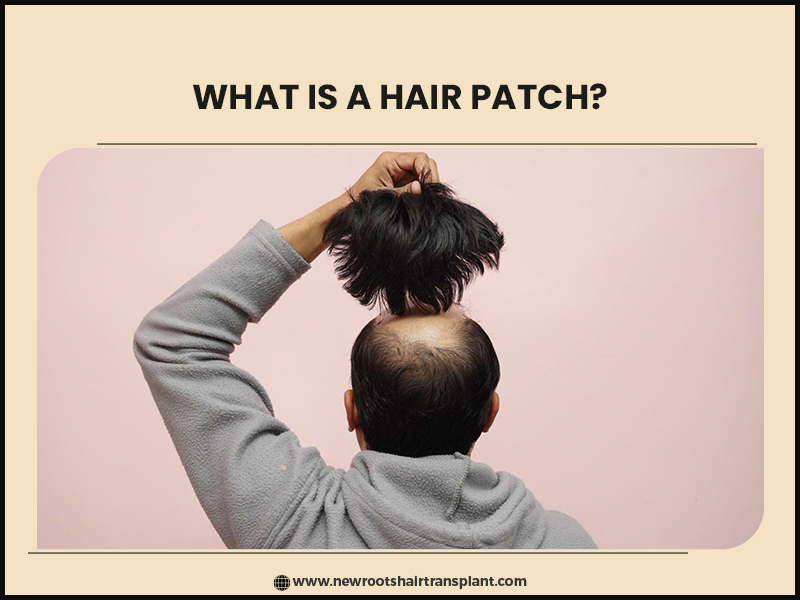
Have you been struggling with hair loss and considering options to restore your hair ?
Two popular hair loss solutions that often come up in discussions are hair patches and hair transplants.
But which hair loss solution is the best ?
In this article, we will compare the two methods based on various factors to help you make an informed decision.
Let's dive in!
Hair loss can significantly impact a person's self-esteem and confidence.
Fortunately, there are several options available to address this issue.
Hair patches and hair transplants are two widely used methods that offer different approaches to hair restoration.

A hair patch, also known as a hairpiece or a wig, is a non-surgical solution to hair loss.
It involves attaching a synthetic or natural hair system to the scalp using adhesives or clips.
Hair patches come in different sizes and styles, allowing customization to match the individual's hair colour, texture, and desired look.

A hair transplant is a surgical procedure that involves extracting hair follicles from a donor site, typically the back of the head, and implanting them into the areas experiencing hair loss.
The transplanted hair follicles continue to grow naturally, providing a permanent solution to hair loss.
One significant aspect to consider when choosing between a hair patch and a hair transplant is the cost.
Hair patches are generally more affordable upfront compared to hair transplants, which require surgical expertise and specialized equipment.
However, it's important to consider the long-term costs, as hair patches may need to be replaced periodically.
The procedure for getting a hair patch is non-invasive and does not require surgery.
It can be done quickly and easily, with the option to remove the patch whenever desired.
On the other hand, hair transplants involve a surgical procedure that requires local anaesthesia.
The process includes the extraction, preparation, and transplantation of hair follicles, which can take several hours to complete.
Hair patches offer immediate results, instantly giving the appearance of a full head of hair.
However, they are temporary solutions and need to be removed and reattached regularly.
Hair transplants, on the other hand, provide a permanent solution as the transplanted hair follicles continue to grow naturally.
The results of a hair transplant are long-lasting and often indistinguishable from natural hair.
Since hair patches are non-surgical, there is no recovery period or downtime involved.
You can resume your daily activities immediately after attaching the patch.
In contrast, hair transplants require a recovery period of a few days to a week.
The scalp may experience some redness, swelling, or scabbing initially, which subsides over time.
When it comes to achieving a natural look and feel, hair transplants have the upper hand.
Since the transplanted hair follicles are taken from your own scalp, they blend seamlessly with your existing hair.
The results are often indistinguishable from natural hair growth, providing a natural and undetectable appearance.
Hair patches, although they can be customized to match your hair colour and texture, may not offer the same level of realism as a hair transplant.
Hair patches require regular maintenance and upkeep. They need to be removed, cleaned, and reattached periodically.
The adhesives used may lose their effectiveness over time and require replacement.
Additionally, styling and maintenance of the hair patch need to be done carefully to ensure a natural look.
Hair transplants, on the other hand, require minimal maintenance.
The transplanted hair can be treated and styled just like your natural hair, without the need for any specialized care.
The suitability of hair patches and hair transplants may vary depending on individual cases.
Hair patches are a viable option for individuals with temporary hair loss or those who want to experiment with different hairstyles without committing to a permanent solution.
They are also suitable for individuals who are not eligible for surgical procedures.
Hair transplants, on the other hand, are recommended for individuals with permanent hair loss and those seeking a long-term, permanent solution.
When it comes to deciding between a hair patch and a hair transplant, it's always best to seek advice from experts in the field.
Consulting with a qualified trichologist or a hair restoration specialist will help you understand your specific case, discuss your expectations, and determine the most suitable option for you.
These professionals can provide personalized recommendations based on your unique needs and circumstances.
Hair transplants are typically performed in areas with significant hair loss or thinning. The suitability of a hair transplant on a specific area of the scalp depends on factors such as donor hair availability and the condition of the recipient site. A consultation with a hair transplant specialist can determine the feasibility of the procedure for your specific case.
There are generally no specific age restrictions for a hair transplant. The suitability of the procedure depends on factors such as the individual's overall health, the extent of hair loss, and the stability of the donor hair. A thorough evaluation by a hair transplant specialist can determine if you are a suitable candidate, regardless of your age.
A skilled hair transplant surgeon can recreate a natural-looking hairline by carefully designing the placement of transplanted hair follicles. The expertise of the surgeon and their attention to detail play a crucial role in achieving a natural and aesthetically pleasing result. Consulting with an experienced hair transplant specialist can help you understand the expected outcome and the potential for a natural-looking hairline.
In conclusion, the choice between a hair patch and a hair transplant depends on various factors such as cost, procedure, effectiveness, longevity, recovery, risks, natural look, maintenance, and suitability.
Hair patches offer a non-surgical and affordable option for temporary hair loss, while hair transplants provide a permanent solution with natural-looking results.
It's crucial to weigh the pros and cons, consider expert recommendations, and make an informed decision based on your individual needs and preferences.